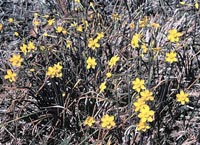Resource Library
Plant of the Week: Jonquil
The University of Arkansas System Division of Agriculture does not promote, support or recommend plants featured in "Plant of the Week." Please consult your local Extension office for plants suitable for your region.
Plant of the Week
Jonquil
Latin: Narcissus jonquilla

Names are a part of life, and in horticultural names are critical in our understanding of plants. But the bewildering tapestry of names that confront gardeners – everything from the Latin binomial to several equally valid common names for any given plant – cause confusion, even among the pros in the field.
Jonquil is one of the plants whose name has been erroneously applied to some of its kin, clouding the issue of identify. Jonquil is one of the species narcissus, collectively known as daffodils, that was introduced into gardens from its native home in Spain and Portugal.
Jonquil flowers in March and April on slender stems about 16 inches tall. Each stem bears two to six fragrant, bright yellow blossoms that are about the size of a quarter. The cup of the plant is tiny, usually only about one-fourth as long as the petals of the flower.
Jonquil is the most fragrant of all the Narcissus species. Its scented hybrids can often trace their fragrance back to this species.
The leaves are unlike those of the typical daffodil. They’re a black, greasy green color, round in shape with a groove down the upper surface. They begin growing from the slender bulb during the mild days of the fall. By spring, when the plants flower, the tips are often burned by severe winter weather.
The jonquil has a long history of cultivation. It’s generally believed that Roman soldiers
introduced the plant into England during the early years of the Christian era. They believed that the mucilaginous sap of the bulb had curative properties, which turns out not to be the case.
The name Jonquil is derived from the Spanish word jonquillo, which is a kind of rush and refers to the rush-like leaves of the bulb.
The name "daffodil" comes to us from the Greek word "asphodel," which was used to refer to any of several species of bulbous plants that bloomed in the spring. In Greek mythology, the asphodel was believed to cover the pastures of hell. When the word was introduced into England by Roman soldiers, the name was applied to the non-fragrant, single-flowered Narcissus we know today as the daffodil.
With the introduction of both multiple-flowered jonquils and single-flowered daffodils into the Colonies, some name swapping seems to have taken place. The small-flowered jonquil has never been as popular in American gardens as the single-flowered daffodil. In the South, the name "jonquil" seems to have been used for the more common single-flowered form, which correctly should be called "daffodil."
I’ve also heard daffodils called "Easter lilies" in rural parts of Arkansas, so the mixup between daffodil and jonquil is infinitely less confusing than calling the plant a lily.
Jonquils are not commonly available from bulb merchants, but they are common around old gardens and cemeteries. They can be dug and divided during any season, but the best time for division is in late spring as the foliage begins to die down.
Jonquils do best in full sun but will tolerate light shade and still bloom well. Once established, the plants require little care until it’s time for you to divide plants to share with your gardening friends.
By: Gerald Klingaman, retired
Extension Horticulturist - Ornamentals
Extension News - March 30, 2001
The University of Arkansas System Division of Agriculture does not maintain lists of retail outlets where these plants can be purchased. Please check your local nursery or other retail outlets to ask about the availability of these plants for your growing area.